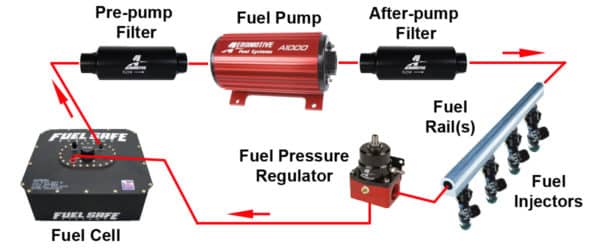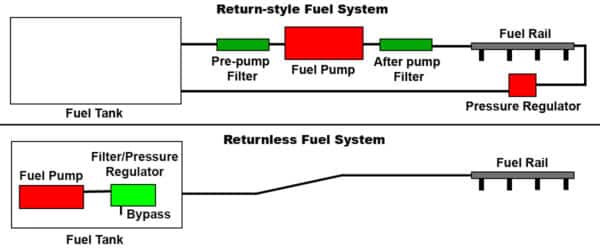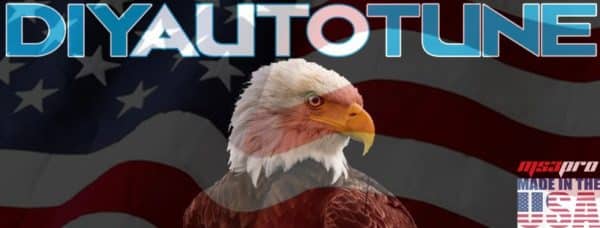Updated October 2022 by Jerry Hoffmann
Chapter 5A – Understanding the Electronic Fuel Injection / EFI Fuel System: Overview
In this article we will be giving an overview of the EFI Fuel System, and discussing some of the things to consider when either taking control of a factory fuel system, or building a fuel system from scratch to meet your needs. Heads up…. this chapter covers a lot of information, and as such, was getting long. I decided to break it up into smaller chunks, so instead of a single 30 page long Chapter 5, we’ll be offering this up as 4 smaller articles/sub-chapters, to keep things flowing, and to keep from overwhelming anyone hopefully (especially me!).
So read on!– what do we need to consider when assessing if our current fuel system is up to the task we’re about to ask of it? Or in the case of those converting over from a carburetor to fuel injection– or building a brand new fuel system from scratch for a race car– what do we need to consider and plan for along the way?
Carb-To-EFI Crew: If you’re coming from a carbureted engine converting to fuel injection, there are some key differences to understand and account for in your Carb-to-EFI Conversion. You may have to modify or replace your fuel tank, run a return line, you’ll be running higher fuel pressures, etc. We’ll get into it below and try and cover it all!
Factory EFI Takeover Crew: If you’re taking over control of a factory EFI vehicle that already has an EFI fuel system in place, you likely have most of the work done for you already. You may have to upgrade certain components, in some cases just the fuel pump perhaps, to make your power goals. Or if you’re making big power gains over the factory system, you may have to run new fuel lines to carry the additional fuel you’ll need to feed that power! In some cases, you’ll be going so big that you’re designing the full fuel system from scratch and you’re in the same boat as those covering to EFI from a carb! We’ll try to cover each piece in the chain below to help you understand all you need to in order to accomplish your goals!
On a carbureted vehicle, the fuel system is pretty simple. You generally have a single fuel line from the gas tank up to the engine bay. In most cases you will have a mechanical fuel pump bolted to the side of the engine block, pulling fuel from the tank and pumping it up to the carburetor where it is ‘dead headed’ into the carb without a separate regulator. Dead headed meaning there is no return fuel line. Your factory carbureted fuel system obviously doesn’t provide the fuel pressure and flow needed when converting to EFI, so a few changes will need to be made. We’ll discuss that in detail below.
On a factory EFI vehicle, you will commonly have a Return Fuel System with a main fuel line feeding fuel to the engine bay, specifically to the fuel pressure regulator, and a return line going from the regulator back to the fuel tank returning excess fuel in an endless cycle.
Return versus Returnless Fuel Systems
On some vehicles starting in the 90’s, and becoming more common in the early 2000’s and later, you may have a Returnless Fuel System which only has a single line from the fuel tank and regulator which are usually located inside the pump, to the engine, with the ECU controlling the fuel pump to regulate the fuel flow needed under different load conditions. In either case, the job of the fuel system is to get the fuel from the tank to the injectors and to maintain the proper fuel pressure at all times under all operating conditions, be it idle, cruise, or full throttle.
The MS3Pro Engine Management Systems we manufacture right here in Gainesville, GA USA are capable of controlling a Return or Returnless Fuel System. In most cases, you’ll only use Returnless if you’re modifying a car where it’s already there, and even then, for wilder performance builds, you will commonly be converting to a return based fuel system. The fact is, there are just more parts available to reach your wilder power goals generally with return fuel systems. You’re not limited to what size pump you can fit in the tank, you can go external. You’re also able to increase the size of the fuel lines dramatically if needed, and or run multiple fuel pumps in some cases, either all the time or on demand, which we’ll discuss further below.
For most of our customers, a Return Fuel System will make the most sense for Carb Conversions and for bigger builds even in Factory EFI cars- therefor we’ll concentrate on Return Fuel Systems by and large in this article series.
Fuel Pressure – how much should you run?
Typically a TBI Fuel Injection System runs at 10-12psi of Fuel Pressure.
On a MultiPort Fuel Injection System, or a Sequential Port Fuel Injection System, the fuel pressure is going to be higher. Commonly 43.5 psi (or 3 bar) of base fuel pressure, sometimes higher.
Fuel Tank, Fuel Pump, Filters, and lines
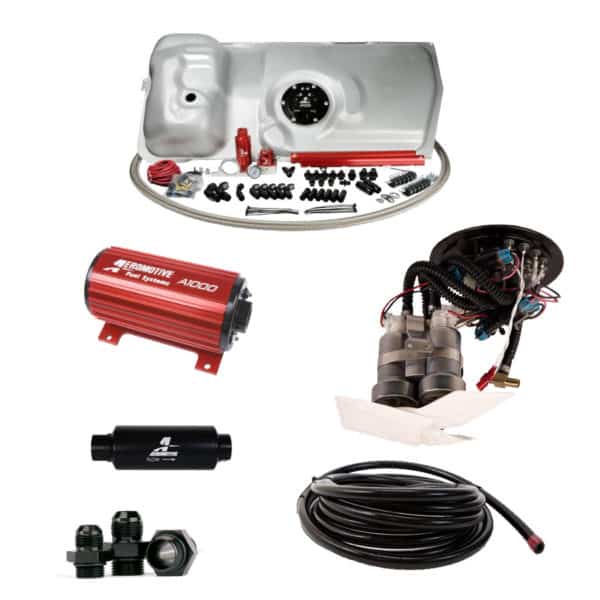
Again, you Factory EFI Takeover Crew peeps will likely be just fine here in many cases. In some cases regarding the fuel tank, particularly at higher horsepower levels you could need to increase your fuel line sizing in some cases, or if you will be operating the vehicle under high G forces when turning, accelerating, or braking, you may find you need to consider some additional baffling.
Your factory fuel pump, filters, and lines will be perfectly adequate for stock horsepower levels, and usually for reasonable gains above factory horsepower and torque numbers. Just what is reasonable though? It really just depends on what the factory gave you to start with, some vehicles are well equipped from the factory to make TWICE the factory horsepower with the stock parts or maybe just with a simple fuel injector upgrade. Some vehicles will only be able to handle 20% or 30% more than factory horsepower levels without a little more work, maybe just a fuel pump upgrade, or maybe more. It’s probably advisable to do a little research on a forum dedicated to your car or engine to find what others experiences are. When do they find they need to increase the capacity of the fuel pump? Find the right forum, and search the old posts using the forum search feature– you’ll likely learn just what you need to know pretty quickly. (oh, and tell people there to come check out the EFI Tuners Guide!)
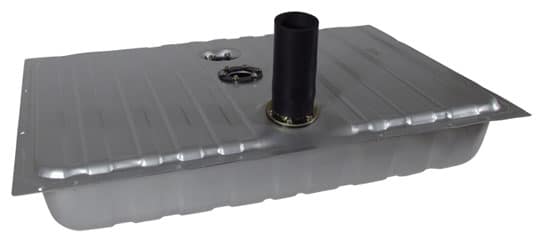
For you Carb-To-EFI Conversion guys, you’ll either need to modify your fuel tank (or filler tube!) to add a return line back to the fuel tank, or fit your vehicle with an aftermarket fuel tank or cell that is designed for Electronic Fuel Injection. Many commonly modified classic cars will have an off-the-shelf aftermarket fuel tank that directly fits the factory location and is designed for EFI. In some cases using an internal fuel pump, which is great if the pump fits your horsepower goals, or alternately you can use an external fuel pump. Though I haven’t used it yet, this tank from Tanks Inc is a direct fit for my 1965 Ford Mustang that I plan to convert over to EFI and do a case study on later in this article series. It fits an EFI fuel pump internally as well as a level sending unit to work with the factory gauges… I plan to reach out to them when the time comes!
Under the hood – Regulator, Fuel Rails, Pulsation Dampener, and Injectors
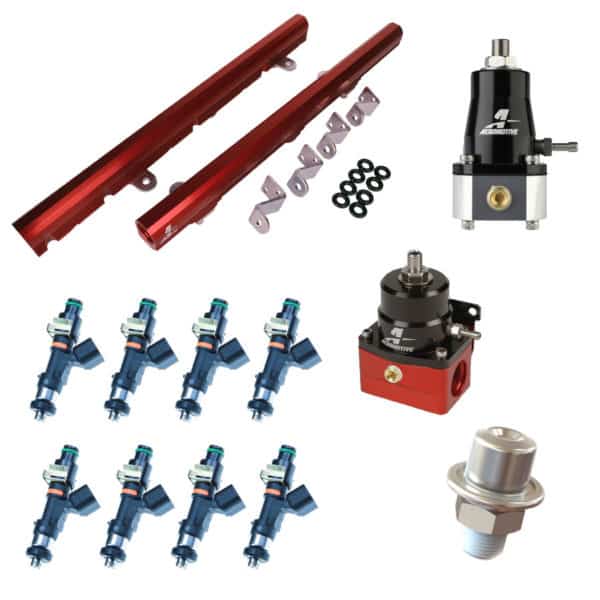
Similar story to the above– for you Factory EFI guys, you can often re-use what’s there for goals of moderate power gains. Perhaps needing to upgrade the size of your fuel injectors, but the other bits will likely work just fine up to a point. If you go from mild/moderate to wild though, you’ll be upgrading the other bits here as well. If your fuel pump is big enough to outflow the Fuel Pressure Regulator’s ability to regulate pressure, you’ll need to upgrade. Same goes for fuel rails and possibly pulsation damper, if your injectors get big enough to impact the pressure in the fuel rail when they fire, increasing the size of that fuel rail can help ensure the pressure in the rails stays steady which will aid in making sure you get consistent fuel through the injectors.
For you Carb-To-EFI Conversion guys you’ll be spec’ing all of these parts out as a part of designing your EFI system. It’s not difficult to do, but you do want to put just a bit of thought into what parts you choose based on your goals. We plan to help you in later chapters with sizing these components, in the meantime, feel free to send us an email and ask for help! We offer many of the Fuel System parts you may need here at DIYAutoTune.com.
What fuel, or fuels, do you plan to run?
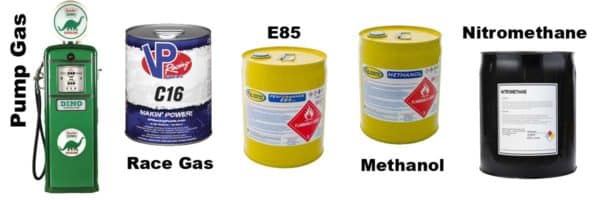
The fuel you plan to run will impact choices you make from the fuel tank and pump all the way to the injector. For gasoline or common E15 gasoline usage, you won’t have to put too much thought into this. If you’re planning to run E85, or Methanol, or something crazy like NitroMethane (yeah baby!) you’re going to want to ensure you not only size all components properly but that you also ensure that all components are compatible with your fuel of choice. I’m going to assume most of you are running gasoline or E15 for much of this article series, however we’ll talk about E85/Flex Fuel as well as some of the popular race fuels like Methanol as well.
The EFI Fuel System: Going Deeper…
In the following articles labeled Chapters 5B, 5C, 5D, etc we’ll get into each of these fuel system components and discuss them each at a deeper level to help you know know exactly what you need in order to be able to spec your fuel system out properly the first time. Starting with Fuel Tanks and Fuel Pumps and going through all of the major components. Click the link below to read the next chapter!
>>> Read Chapter 5B -The EFI Fuel System: EFI Fuel Tanks and Pumps >>> (Coming Soon- ETA 10/27!)
<<< Go Back to Chapter 4 – Electronic Fuel Injection Options – TBI, MPFI, SPFI, ITBs and DI <<<
*** Return to the Table of Contents ***
Click Here to check out our MADE IN THE USA Engine Management Systems!

Copyright 2022 Hoffmann Innovations Inc. aka DIYAutoTune.com
